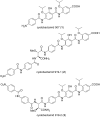Marine-derived myxobacteria of the suborder Nannocystineae: An underexplored source of structurally intriguing and biologically active metabolites
- PMID: 27340488
- PMCID: PMC4902002
- DOI: 10.3762/bjoc.12.96
Marine-derived myxobacteria of the suborder Nannocystineae: An underexplored source of structurally intriguing and biologically active metabolites
Abstract
Myxobacteria are famous for their ability to produce most intriguing secondary metabolites. Till recently, only terrestrial myxobacteria were in the focus of research. In this review, however, we discuss marine-derived myxobacteria, which are particularly interesting due to their relatively recent discovery and due to the fact that their very existence was called into question. The to-date-explored members of these halophilic or halotolerant myxobacteria are all grouped into the suborder Nannocystineae. Few of them were chemically investigated revealing around 11 structural types belonging to the polyketide, non-ribosomal peptide, hybrids thereof or terpenoid class of secondary metabolites. A most unusual structural type is represented by salimabromide from Enhygromyxa salina. In silico analyses were carried out on the available genome sequences of four bacterial members of the Nannocystineae, revealing the biosynthetic potential of these bacteria.
Keywords: Enhygromyxa; Nannocystineae; genome mining; myxobacteria; natural products.
Figures













Similar articles
-
Marine Myxobacteria: A Few Good Halophiles.Mar Drugs. 2018 Jun 14;16(6):209. doi: 10.3390/md16060209. Mar Drugs. 2018. PMID: 29899205 Free PMC article. Review.
-
Metabolic and Biosynthetic Diversity in Marine Myxobacteria.Mar Drugs. 2018 Sep 5;16(9):314. doi: 10.3390/md16090314. Mar Drugs. 2018. PMID: 30189599 Free PMC article. Review.
-
Future Directions of Marine Myxobacterial Natural Product Discovery Inferred from Metagenomics.Mar Drugs. 2018 Aug 29;16(9):303. doi: 10.3390/md16090303. Mar Drugs. 2018. PMID: 30158489 Free PMC article. Review.
-
Enhypyrazinones A and B, Pyrazinone Natural Products from a Marine-Derived Myxobacterium Enhygromyxa sp.Mar Drugs. 2019 Dec 12;17(12):698. doi: 10.3390/md17120698. Mar Drugs. 2019. PMID: 31842310 Free PMC article.
-
Analysis of the Genome and Metabolome of Marine Myxobacteria Reveals High Potential for Biosynthesis of Novel Specialized Metabolites.Sci Rep. 2018 Nov 9;8(1):16600. doi: 10.1038/s41598-018-34954-y. Sci Rep. 2018. PMID: 30413766 Free PMC article.
Cited by
-
Myxobacteria as a Source of New Bioactive Compounds: A Perspective Study.Pharmaceutics. 2021 Aug 16;13(8):1265. doi: 10.3390/pharmaceutics13081265. Pharmaceutics. 2021. PMID: 34452226 Free PMC article. Review.
-
Macroevolutionary Dynamics in Micro-organisms: Generalists Give Rise to Specialists Across Biomes in the Ubiquitous Bacterial Phylum Myxococcota.Mol Biol Evol. 2024 May 3;41(5):msae088. doi: 10.1093/molbev/msae088. Mol Biol Evol. 2024. PMID: 38717941 Free PMC article.
-
Engineering Pseudochelin Production in Myxococcus xanthus.Appl Environ Microbiol. 2018 Oct 30;84(22):e01789-18. doi: 10.1128/AEM.01789-18. Print 2018 Nov 15. Appl Environ Microbiol. 2018. PMID: 30217842 Free PMC article.
-
A novel cyanobacterial geosmin producer, revising GeoA distribution and dispersion patterns in Bacteria.Sci Rep. 2020 May 26;10(1):8679. doi: 10.1038/s41598-020-64774-y. Sci Rep. 2020. PMID: 32457360 Free PMC article.
-
Bacterial Natural Product Drug Discovery for New Antibiotics: Strategies for Tackling the Problem of Antibiotic Resistance by Efficient Bioprospecting.Antibiotics (Basel). 2021 Jul 10;10(7):842. doi: 10.3390/antibiotics10070842. Antibiotics (Basel). 2021. PMID: 34356763 Free PMC article.
References
-
- Reichenbach H. Myxobacteria: A Most Peculiar Group of Social Prokaryotes. In: Rosenberg E, editor. Myxobacteria. New York, NY: Springer; 1984. pp. 1–50. ((Springer Series in Molecular Biology)). - DOI
Publication types
LinkOut - more resources
Full Text Sources
Other Literature Sources
Molecular Biology Databases
